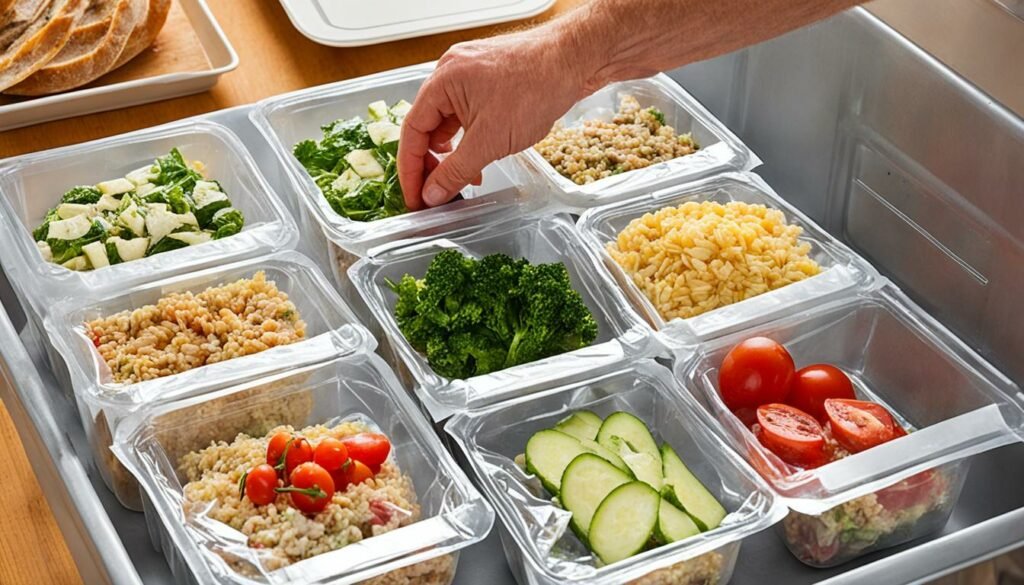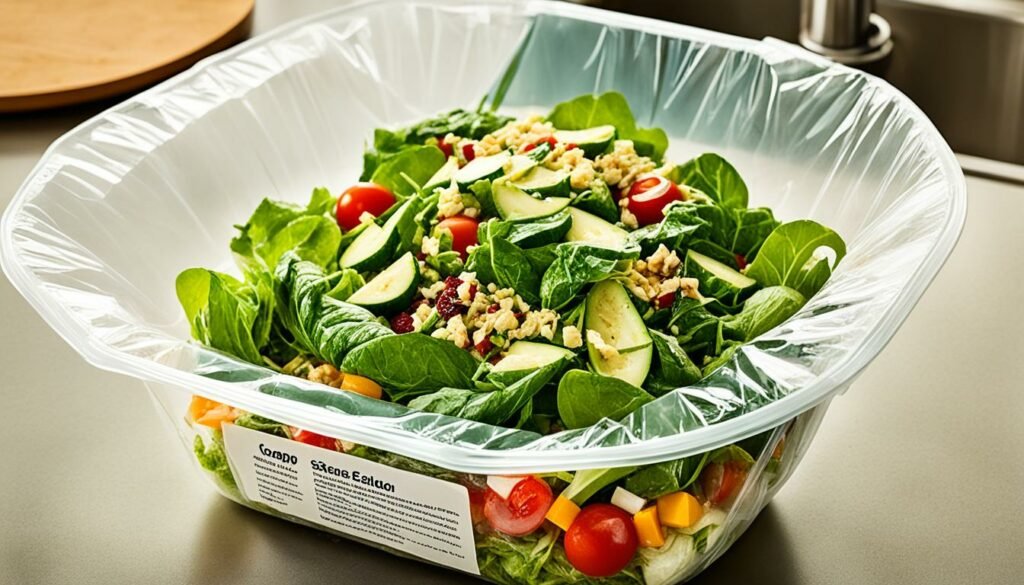Have you ever thought keeping food fresh could be easier, without the cost of vacuum sealers?

My fridge often makes me wonder about better ways to store food. I focus on keeping food fresh and easy to manage. Plastic wrap has some secrets it hasn’t shared widely before.
While vacuum sealers are great, plastic wrap is an easy choice. In this article, we’ll look at both. We’ll see the good sides and the not-so-great parts of each. You’ll learn how plastic wrap can really make a difference in your kitchen. It brings together doing a good job and being simple to use.
Understanding Food Storage Methods
Food storage methods have changed a lot from the old ways to what we use now. These changes are all about keeping food fresh longer. I’ve noticed how these new ways are better at preserving food’s quality.
Traditional Preservation Techniques
In the past, people kept their food fresh using salt, smoke, and by canning. While these ways worked, they could change how the food tasted and felt.
Modern Approaches to Food Storage
Today, we can choose from many ways to store our food. Things like the fridge and freezer help a lot. But now, we also have methods like using special packaging that keeps the air around the food just right. This keeps the food from spoiling and keeps it tasty.
The Rise of Vacuum Sealing
Vacuum sealing is becoming a favorite for keeping food fresh longer. This method takes the air out of the package. It can make food last up to five times than usual. It works really well for meats, veggies, and dried foods.
- Reduces food waste
- Allows for bulk purchasing
- Saves money in the long run
- Preserves food quality better than plastic wrap
For example, if you vacuum seal meat or fish, it can last 4-5 days in the fridge. Without this sealing, it would only last a day. This shows how big of a difference vacuum sealing can make in your kitchen.
Plastic Wrap vs Vacuum Sealing: A Comparison
I’ve looked into plastic wrap and vacuum sealing for storing food. Both ways have their advantages. Plastic wrap is quick to use and great for storing food short term. Vacuum sealing, on the other hand, compresses food tightly and removes air well. This makes it perfect for keeping food fresh longer.
Vacuum sealing is better at keeping air out. It decreases the chance of freezer burn and makes food last longer. Plastic wrap, though not as good, can still protect food well if you use it right.
Cost is important too. Plastic wrap is usually cheaper for daily use. Vacuum sealers cost more at first. But, they can help you save money by not wasting food.
| Feature | Plastic Wrap | Vacuum Sealing |
|---|---|---|
| Application Speed | Quick | Moderate |
| Air Removal | Partial | Near-complete |
| Initial Cost | Low | High |
| Long-term Savings | Moderate | High |
| Versatility | High | Moderate |
Choosing between plastic wrap and vacuum sealing depends on your needs and budget. For daily leftovers, plastic wrap is the way to go. It’s easy to use and costs less. For storing lots of food or keeping expensive items fresh, vacuum sealing is better. It keeps air out really well.
Benefits of Using Plastic Wrap for Food Storage
Plastic wrap is an excellent choice for keeping food fresh. It’s great at stopping fresh food from going to waste. Many people use it because of the benefits it brings.
Cost-Effectiveness and Accessibility
It’s cheap and easy to find in stores. This makes it a budget-friendly way to store food. Using plastic wrap means you throw away less food. Research shows it can extend the life of cucumbers by 11 days and bananas by 21 days.
Versatility in Application
Plastic wrap is perfect for many uses. You can cover bowls, wrap odd shapes, or pack up leftovers. This keeps food fresh and easy to save. Beef, for instance, will last 26 days longer when vacuum-sealed in plastic.
Ease of Use for Quick Storage
Using plastic wrap is simple and quick. You don’t need any special tools. It’s perfect for families and people on the go. Food stays fresh without complicated steps.
Plastic wrap helps cut down on food waste a lot. In the U.S., we waste about 30 to 40% of the food we grow each year. By wrapping food, we can save money and help the environment.
Limitations of Plastic Wrap in Food Preservation
Plastic wrap is handy but not great at keeping food fresh for long. It doesn’t do as well as vacuum packaging in two important ways. These are making food last longer and sealing tightly.
Plastic wrap can’t lock out air as well as vacuum sealing can. So, food doesn’t stay fresh as long. If you want your food to last longer, vacuum sealing is a better bet. Vacuum sealing keeps food fresh by stopping bacteria and mold growth.

Plastic wrap is also not good for sous vide cooking, unlike vacuum seal bags. These bags handle high heats, making them more versatile for modern cooking methods.
Let’s look at how plastic wrap and vacuum sealing compare for storing meat:
| Aspect | Plastic Wrap | Vacuum Sealing |
|---|---|---|
| Freezer Storage Time | Couple of months | Couple of years |
| Airtight Seal | Partial | Complete |
| Freshness Retention | Moderate | Excellent |
| Suitability for Irregular Shapes | Poor | Good |
| Sous Vide Cooking | Not Suitable | Suitable |
Plastic wrap is okay for storing food briefly. But for keeping food fresh and safe for a long time, vacuum sealing wins. It’s clear that vacuum sealing is better for long-term food storage and freshness.
Environmental Considerations: Plastic Wrap and Vacuum Sealing
Choosing how we store food impacts the environment greatly. I’ve looked into several ways to store food better. This is to help you lower waste and pick eco-friendly options.
Waste Reduction Strategies
Vacuum sealing is great for stopping food from going bad. It makes food last 3-5 times longer than usual, meaning less food gets tossed. In France, each person throws out about 30kg of food yearly. So, using vacuum sealing can make a big difference.
Eco-Friendly Alternatives
Most vacuum seal bags can be recycled but not broken down by nature. Yet, there are better alternatives out there:
- Biodegradable vacuum seal bags like Eco Pouch
- Cellophane bags made from plant cellulose
- ECO Flat HeaT Seal Bags made from corn
These choices give you greener ways to store your food. Just remember, they might not work with all cooking methods.
Reusability and Recycling Options
Using things more than once is a big win against plastic waste. Some vacuum seal bags are made for using again, especially for dry foods. This is good for both your wallet and the planet.
| Storage Method | Reusability | Recycling | Waste Reduction |
|---|---|---|---|
| Vacuum Seal Bags | Moderate | Yes | High |
| Biodegradable Bags | Low | Compostable | Very High |
| Plastic Wrap | Low | Limited | Low |
Choosing sustainable methods and reusing items helps a lot. It cuts down our harm on the planet. Plus, it keeps our food fresh for longer.
Conclusion
I’ve looked into how plastic wrap compares to vacuum sealing for storing food. Both methods do well at keeping food fresh. Plastic wrap is great for quick storage and is good for the wallet. But if you need to keep food fresh for a long time, vacuum sealing is better.
Choosing the right method depends on what you need. Ziploc’s vacuum system is a good option if you want the benefits of both. It’s a nice choice for first-time vacuum sealer users too.
Knowing about these methods can help us make better decisions. We can think about the cost, how easy it is to use, and our storage time. The right choice can help us waste less and have food stay fresh longer.
FAQ
What are the main differences between plastic wrap and vacuum sealing?
Vacuum sealing is great for keeping food fresh longer by removing more air. It’s best for preserving food for a long time. On the other hand, plastic wrap is fast and simple to use for short storage periods. Plus, you don’t need special equipment for plastic wrap, making it cheap and easy to find.
Which method is more cost-effective?
Plastic wrap is more budget-friendly than vacuum sealing. Vacuum sealers can be quite costly. However, products like Ziploc’s vacuum bags with a pump are a good deal. They work like the more expensive FoodSaver but cost less.
Are there any limitations to using plastic wrap for food storage?
Plastic wrap doesn’t seal as tightly as vacuum sealing. This means some air might get in, affecting longer storage times. It’s also not good for cooking sous vide.
What are some eco-friendly alternatives to plastic wrap and vacuum seal bags?
Better for the planet choices include Eco Pouches for vacuum sealing. There are also cellophane bags from plant material and ECO Flat HeaT Seal Bags made from corn. But keep in mind, they might not work for all temperatures and storage times.
Can vacuum seal bags be reused or recycled?
Yes, many vacuum seal bags can go in with plastic bags for recycling. Some are even good for storing dry goods again. But remember, they aren’t biodegradable. Thinking about how you dispose of them or recycle them is crucial for the planet.
